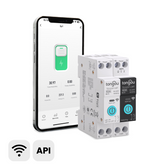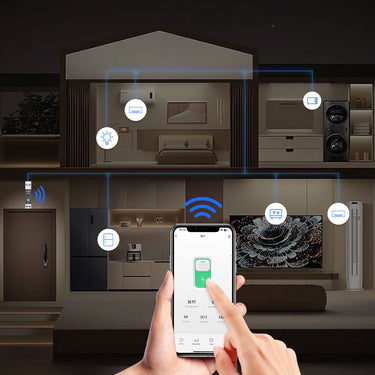Understanding Voltmeters: From Basic Definitions to Practical Applications

From managing household appliances to servicing sophisticated machinery, dealing with electronics is a near-universal experience. Central to diagnosing and maintaining these systems are essential tools like the voltmeter, an instrument designed to precisely measure electrical potential difference (voltage) between two points. Though seemingly simple, voltmeters are critical in fields like telecom, automotive repair, and even home DIY projects. This compelling guide will demystify the indispensable voltmeter, compare it with its versatile cousin – the multimeter – and empower you to confidently use these tools. Step into the fascinating world of electronics as we unravel these essential instruments, their functionality, and their vital applications.

Understanding Voltmeters
In the realm of electronics, the voltmeter proudly stands as an indispensable tool for anyone needing accurate voltage readings. Conceived in the 19th-century scientific revolution, the voltmeter's primary job is to measure the electric potential difference, commonly known as voltage, between two points in an electrical circuit. In layman's terms, it quantifies the "electrical pressure" or force pushing electricity through a circuit, a crucial diagnostic for system health and safety.
Voltmeters come in various forms, with each designed to meet specific needs. Broadly, they're divided into two types: analog and digital. Analog voltmeters, also known as voltage meters or VOM (Volt-Ohm meter), make use of a physical needle on a dial to indicate voltage. On the other hand, digital voltmeters (DVM) display voltage readings on a digital display, offering higher accuracy and readability.
Voltmeters come in various forms, with each designed to meet specific needs. Broadly, they're divided into two types: analog and digital.
-
Analog Voltmeters: Often referred to as VOM (Volt-Ohm Meter) when part of an analog multimeter, these use a physical needle on a calibrated scale to indicate voltage. They are valued by some for their ability to show fluctuating readings smoothly.
-
Digital Voltmeters (DVM): These display voltage readings on a clear digital screen (LCD or LED), offering higher accuracy, easier readability, and often additional features.
Internally, a voltmeter's structure usually includes a display, a dial or switches, and input jacks that accommodate probes.
-
Display: Shows the voltage reading (analog needle or digital numbers).
-
Dial/Switches: Used to select the measurement type (AC or DC voltage), the appropriate voltage range (e.g., 2V, 20V, 200V, 600V), and sometimes other features.
-
Probes: A pair of color-coded leads (typically red for positive, black for negative/ground) used to connect the voltmeter to the circuit.
Understanding the nuances of a voltmeter and how it operates is the stepping stone toward accurate and efficient diagnostic, repair, and monitoring activities related to circuits and electrical appliances.
Understanding Multimeters
Just as crucial in any electronics toolbox is the multimeter. It essentially incorporates the functionality of a voltmeter but extends its capabilities to measure electrical current (amperage or amps) and resistance (ohms). This makes the multimeter an incredibly versatile "jack of all trades" for comprehensive electrical troubleshooting and testing.
Like voltmeters, multimeters are available as either analog or digital.
-
Analog Multimeters (AMMs): These use a microammeter with a moving pointer to display readings across various scales.
-
Digital Multimeters (DMMs): The more common choice today, DMMs leverage digital and logic circuitry to display precise measurements on an LCD screen. Many DMMs also offer features like continuity testing, diode checking, and even temperature measurement.
The components of a multimeter closely mirror those of a dedicated voltmeter: a display (analog or digital), function switches or a rotary dial to select the desired measurement (voltage, resistance, current, and often specific ranges), and input jacks for the probes.
Integrated into a single compact device, the multimeter fleshes out the functionality of a basic voltmeter, thus proving its value and indispensability in various fields like electronic testing, appliance servicing, automotive diagnostics, and general electrical troubleshooting. This equipment boasts of the convenience of carrying out multiple measurements using just one device, thereby simplifying many technical jobs and diagnostics.
Voltmeter vs. Multimeter
While both voltmeters and multimeters prominently feature in the realm of electronic measurement tools, there remain to be considerable differences between the two. Recognizing their distinct features and capabilities helps channel their unique strengths into appropriate applications.
Functionality:
-
Voltmeter: As established, a voltmeter measures only voltage between two points in a circuit. It is specialized for this purpose.
-
Multimeter: True to its name ("multi-meter"), it can measure multiple electrical parameters: voltage (AC/DC), current (AC/DC), and resistance. Many also test continuity, diodes, transistors, and capacitance, offering a broader range of diagnostic capabilities in one tool.
Precision and Accuracy:
-
Voltmeter: Since a dedicated voltmeter is designed solely to measure voltage, it can sometimes offer higher precision and sensitivity for this specific measurement, especially in specialized laboratory-grade models.
-
Multimeter: While modern DMMs are highly accurate and versatile, a general-purpose multimeter might not match the extreme exactitude of a specialized, high-end voltmeter for very sensitive voltage measurements. However, for most practical applications, the accuracy of a good quality DMM is more than sufficient.
Application and Use Cases:
The choice between the two largely hinges on your specific needs:
-
Voltmeters (Dedicated): Best suited for tasks requiring exceptionally precise or continuous voltage readings, common in advanced electronics design, scientific research, or specific industrial monitoring where only voltage is the concern.
-
Multimeters: Ideal for general electrical work, electronics hobbyists, automotive repair, household appliance troubleshooting, or situations where workspace is limited and carrying multiple dedicated meters is impractical. If you need to diagnose a variety of electrical issues, a multimeter is almost always the more practical choice.
Quick Comparison Table: Voltmeter vs. Multimeter
| Feature | Dedicated Voltmeter | Multimeter |
| Primary Function | Measures Voltage Only | Measures Voltage, Current, Resistance (and more) |
| Versatility | Low | High |
| Specialization | High (for voltage) | Moderate (across functions) |
| Common Use | Lab research, specific industrial | General electronics, DIY, automotive, field service |
| Cost (General) | Can be higher for precision | Wide range, often cost-effective for features |
Working with a Voltmeter
Voltmeters can offer a wealth of invaluable information about a circuit's health and safety. Here's how one typically works with a voltmeter:
When and Why Use a Voltmeter: Voltmeters come in handy when troubleshooting electrical problems or when trying to understand how electrical power is distributed across a circuit. Normal maintenance procedures or safety measures may require voltage measurement, which can prevent electrical incidents and ensure that appliances are operating correctly.
Installing a Voltmeter: Safety is of utmost importance when installing a voltmeter. Always ensure the power supply is turned off before proceeding. Connect the voltmeter in parallel with the circuit part you wish to measure voltage across, with the red probe attached to the positive end and the black probe to the negative or ground.
Using a Voltmeter: Once you've connected your voltmeter, turn the power supply back on. Depending on your voltmeter type, either read the needle's position on an analog scale or check digital readouts. Some voltmeters will offer additional information, like average voltage, minimal or maximal values, which can be extremely useful in detecting intermittent problems.
Safety Measures: It's important to work in a dry, well-lit environment wearing rubber-soled shoes. Never touch the metal parts of the probe and keep fingers behind the finger guards on the probes. Always inspect your voltmeter before use, looking for cracked casings, broken leads, or other damage.
Common Issues and Their Troubleshooting: In case of inconsistent readings, check if your probes are making good contact and the voltmeter's batteries are not low (for handheld ones). If the needle or display does not move, it's likely that a blown fuse or internal circuit fault is at play, in which case professional repair or replacement is advisable.
Prudent use of a voltmeter can detect potential problems early and help ensure the safe and efficient operation of electrical devices and circuits.
How to Check If a Wire Is Live with a Voltmeter
Here's a step-by-step guide on how to use a voltmeter to check if a wire is live:
Safety Measures: Begin by ensuring you're wearing appropriate protective gear, like rubber-soled shoes and, preferably, insulated gloves. Make sure the area is well-lit and dry as well.
Set Up the Voltmeter: Based on the expected voltage, set your voltmeter to a range that comfortably accommodates it, usually the AC voltage setting for home wiring.
Establish Ground Reference: To check if a wire is electrified (that is, to see if it is live), you need a grounded reference point. This could be a grounded metal box, the ground wire itself (typically green or bare copper), or the neutral wire (commonly white).
Testing the Wire: Touch one probe to the wire you're testing and the other to your ground reference.
Read the Display: After establishing contact, take a look at the voltmeter's display. If the wire is live (has voltage), the voltmeter will display the voltage. In a house circuit, this is typically around 120 volts. If it's not live, the display will read “0 volts”.
Double Check: Repeat the process with another ground reference point to confirm the result.
Always remember: dealing with electricity is potentially dangerous. If you're unsure about anything related to electrical work, it's best to call a professional electrician.
Conclusion
In our electricity-driven world, tools like voltmeters and multimeters are truly indispensable, whether you're a seasoned professional, an automotive enthusiast, or a DIYer tackling household repairs. As we've explored, a voltmeter provides precise voltage measurements, crucial for specific diagnostics, while a multimeter offers a versatile suite of tests – voltage, current, and resistance – making it an all-around champion for general electrical troubleshooting.
The key is to choose the right instrument for your needs. If highly accurate voltage measurement is your sole focus, a dedicated voltmeter might be your pick. However, for most users, the versatility and comprehensive diagnostic power of a quality digital multimeter (DMM) make it the superior and more cost-effective investment.
Understanding how to use these tools safely and correctly not only empowers you to diagnose and fix electrical issues but also promotes a safer working environment. Always prioritize safety, double-check your settings, and if ever in doubt, consult a professional electrician.












